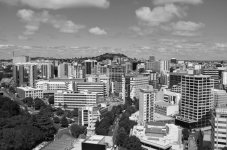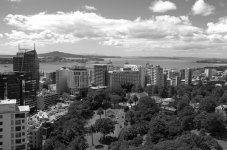hausen
Well-known
Hello all,
Had a little play this afternoon with my new X100. Stood on my deck and took a couple of shots that were tricky for the camera to meter. Set camera to Monochrome with Red filter. Used spot meter to pick a neutral zone, held down AEL button and took the shot. Uploaded to Silkypix (Use PC not Mac) converted to .tiff and imported into LR. Adjusted exposure down a little, sharpened and not much more. Then printed the file on my Canon 9500II and was very quite happy with the overall sharpness of the result. This is just the view from my deck and I snapped a couple to post here, didn't try to make it perfect it was just a test. Am pretty happy with the allround usability, and probably will be using it mainly for B&W camera that I can have with me all the time, and I think it is well suited for that.
Had a little play this afternoon with my new X100. Stood on my deck and took a couple of shots that were tricky for the camera to meter. Set camera to Monochrome with Red filter. Used spot meter to pick a neutral zone, held down AEL button and took the shot. Uploaded to Silkypix (Use PC not Mac) converted to .tiff and imported into LR. Adjusted exposure down a little, sharpened and not much more. Then printed the file on my Canon 9500II and was very quite happy with the overall sharpness of the result. This is just the view from my deck and I snapped a couple to post here, didn't try to make it perfect it was just a test. Am pretty happy with the allround usability, and probably will be using it mainly for B&W camera that I can have with me all the time, and I think it is well suited for that.
Attachments
Keith
The best camera is one that still works!
Those look good.
You lucky bugger ... Im still at least ten days away!

I plan to use mine mainly for black and white and although Silky Pix is copping a bit of a hammering I'll be using it like you to create tifs and then PP'ing the files in my chosen software which is ACDSee Pro. One thing that I like about the Fuji is the inbuilt three stop ND filter which will allow high ISO shooting in fairly bright light at f2. I've discovered with my D700 that NEF's shot at 6400 convert nicely to black and white with the slight noise giving a slightly dirty look ... not like film grain but different enough to that very clean look that converted digi files seem to have.
Have fun!
You lucky bugger ... Im still at least ten days away!
I plan to use mine mainly for black and white and although Silky Pix is copping a bit of a hammering I'll be using it like you to create tifs and then PP'ing the files in my chosen software which is ACDSee Pro. One thing that I like about the Fuji is the inbuilt three stop ND filter which will allow high ISO shooting in fairly bright light at f2. I've discovered with my D700 that NEF's shot at 6400 convert nicely to black and white with the slight noise giving a slightly dirty look ... not like film grain but different enough to that very clean look that converted digi files seem to have.
Have fun!
Catto
Photographer
Good to know someone's keeping an eye on Rangitoto...
R!
R!
willie_901
Veteran
Very nice. Thanks for posting.
eurotramp
Member
@hausen
Same for me, it will replace my (rather my dad's) Minolta Himatic 7. Please keep us posted on your observations as you shoot some more. Thanks.probably will be using it mainly for B&W camera that I can have with me all the time
andrew00
Established
One thing I didn't realist about the ND filter is it's an on or off deal, as in ON it's 3 stops of ND and off it's off.
I thought I could select ND1, ND2 and ND3 as appropriate, but you can't it's just on (3nd) or off.
I thought I could select ND1, ND2 and ND3 as appropriate, but you can't it's just on (3nd) or off.
eurotramp
Member
That is probably dictated by the fact that its a physical ND filter, not a software correction. So its either in an off / on stage. Multiple stops would require multiple physical filters...but you can't it's just on (3nd) or off.
tom in mpls
Member
That makes sense; none the less I had just assumed one would have a choice of ND level. Even so, it's a great feature to have.That is probably dictated by the fact that its a physical ND filter, not a software correction. So its either in an off / on stage. Multiple stops would require multiple physical filters...
eurotramp
Member
related to filters... whats the best way to use a polarizer on the X100 or rangefinders in general?
willie_901
Veteran
related to filters... whats the best way to use a polarizer on the X100 or rangefinders in general?
The X100's EVF will show the effect of a polarized filter in real time. The OVF won't. However once the polarization is optimized, the OVF can be used even though the effect can not be seen. To attach the filter you will need the X100 lens hood attachment which contains an adapter ring; or the optional X100 filter adapter ring; or make your own adapter by gluing two third-party filter adapters together; or wait for a third party to make a cheap knock off of the X100 filter adapter.
For rangefinders without EVFs, you have to adjust the filter for maximum polarization when it is off of the camera. Of course it is trivial to attach the filter to the lens. I haven't used a polarized filter on a RF camera for some time. But I'm sure someone will share a detailed method shortly.
eurotramp
Member
Thanks for your succinct answer Willie.
Perhaps someone else can tell me how people with rangefinders managed in the good old days without an EVF? A history lesson... anyone?
Great, the EVF then has an important role to play for the landscape photographer. I cannot imagine doing landscapes without a polarizer.The X100's EVF will show the effect of a polarized filter in real time.
Perhaps someone else can tell me how people with rangefinders managed in the good old days without an EVF? A history lesson... anyone?
ferider
Veteran
Thanks for your succinct answer Willie.
Great, the EVF then has an important role to play for the landscape photographer. I cannot imagine doing landscapes without a polarizer.
Perhaps someone else can tell me how people with rangefinders managed in the good old days without an EVF? A history lesson... anyone?
In the "good old days" you used polarizers that were viewable through the viewfinder. Either like this: http://www.leicagoodies.com/steps.html, or using a "swing-out" polarizer like #13352.
But I disagree that polarizers are needed for landscapes, in particular in B+W.
Roland.
tapesonthefloor
Well-known
Perhaps someone else can tell me how people with rangefinders managed in the good old days without an EVF? A history lesson... anyone?
For landscape photography in the good old days? They put their rangefinders down and used proper cameras.
Keith
The best camera is one that still works!
For landscape photography in the good old days? They put their rangefinders down and used proper cameras.
Well yeah ... that was my thought too!
tapesonthefloor
Well-known
tapesonthefloor
Well-known
And I said "rangefinger" there, but I'm going to leave it.
ferider
Veteran
Unless you have to schlepp your camera into the mountains, do landscapes while traveling, etc. Obviously, when all your photos are made in ten meter max. distance from your truck (or Vespa, Keith), it don't matter so much.
But again, polarizers are mostly tools for color in landscape photography.
But again, polarizers are mostly tools for color in landscape photography.
Last edited:
eurotramp
Member
IMHO when using a polarizer for black-and-white film, reflections can be reduced, and it can lead to higher image contrast. Of course one can argue that using a red or a green filter will give almost similar results. However I have noticed that with monochrome using a polarizer gives a much more subtle effect than a color filter.But again, polarizers are mostly tools for color in landscape photography.
sepiareverb
genius and moron
I don't see the cat?
Catto
Photographer
Isn't the simplest answer to rotate the filter on your Rangefinder and watch the meter as you do - when it gets to maximum effect (ie. lowest shutter speed or largest aperture) you'll know from the reading...if you go past that point it'll start getting brighter again, and your meter will indicate that as well.
Of course, on the X100 the EVF or rear LCD will be a much easier option; and of course with any digital camera, you can take as many test shots as you like to check the polariser's position.
R
Of course, on the X100 the EVF or rear LCD will be a much easier option; and of course with any digital camera, you can take as many test shots as you like to check the polariser's position.
R
Share:
-
This site uses cookies to help personalise content, tailor your experience and to keep you logged in if you register.
By continuing to use this site, you are consenting to our use of cookies.


